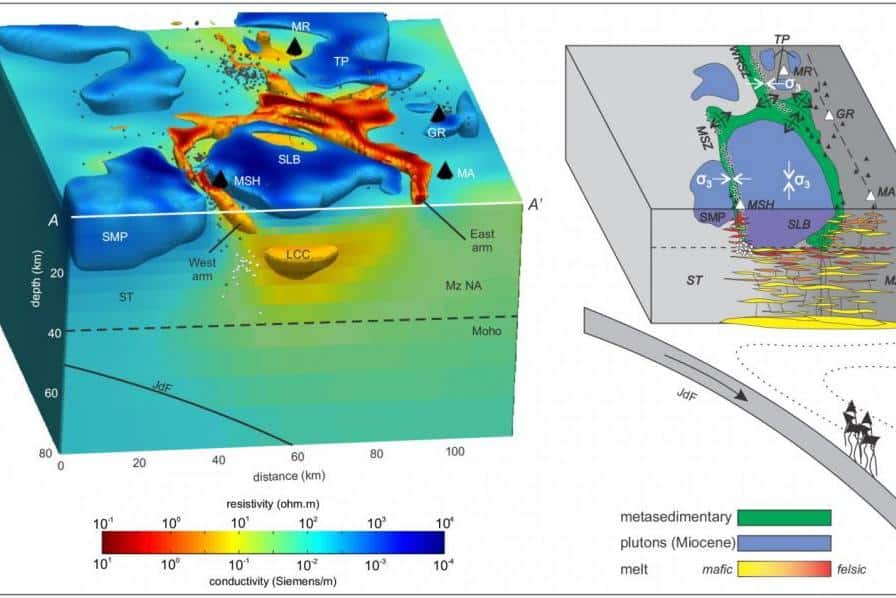
Researchers at Oregon State University report they have discovered that a separate subsurface rock structure is the reason the most active volcano in the Cascade Arc does not line up with its brethren.
New high-resolution images of Earth’s crust explain why Mount St. Helens is out of line with the Cascade Arc of volcanoes.
The images revealed a massive subsurface rock formation beneath Spirit Lake. The batholith diverts magma to the west of the arc, fueling the Cascade’s most active volcano.
Previous attempts to image the region’s subsurface structures relied on seismic waves. When sound waves created by earthquakes and eruptions move through the ground, their frequency and wavelength shift as they pass through different mediums.
Seismic measurements can reveal the properties — the structure, density and temperature — of subsurface rock formations.
The latest images were captured by combining seismic data with “magnetotelluric” data. The measurement of subsurface electrical conductivity can help scientists make similar determinations about the shape, density and temperature of rocks lying beneath the surface.
“Either method by itself can lead to a level of uncertainty, but when you layer them together as we have done in this project you get a much clearer picture of what lies below,” Adam Schultz, an Oregon State University geophysicist, said in a news release. “The longer you run the measurements, the crisper the images and the deeper you can ‘see’ the subsurface.”
By studying the new images, scientists gained an improved understanding of the region’s tectonic history. Today, the Juan de Fuca plate, which forms the ocean floor, is being subducted beneath the Pacific Northwest.
It’s a pattern that has been repeated for several thousand years. In the past, different crustal blocks collided with the North American continent. As a result, marine sediments accreted beneath the surface of the Pacific Northwest.
“This material is more permeable than surrounding rock and allows the magma to move through it,” Schultz said. “The big batholith acts kind of like a plug in the crust and diverted magma that normally would have erupted in line with the other major Cascade volcanoes, resulting in St. Helens forming to the west of the Cascadia Arc, and Mt. Adams slightly to the east.”
Researchers detailed their analysis of Mount St. Helens and the Cascade Arc this week in the journal Nature Geoscience.
In geologic time, Mount St. Helens is relatively young. It formed within the last 40,000 years. It’s most famous eruption occurred in 1980. The event — the deadliest volcanic eruption in U.S. history — killed 57 people.
In the decades since, the volcano has experienced periods of dome-building and dormancy. Scientists hope a new magnetotelluric survey of Mount St. Helens will reveal the movement patterns of the volcano’s magma.
“This may give us a new tool to monitor the magma cycle so we don’t have to wait for the dome-building phase to tell us conditions are changing,” Schultz said.
























